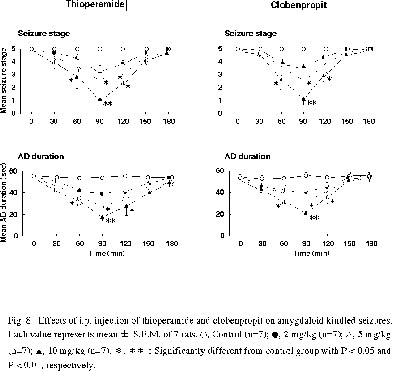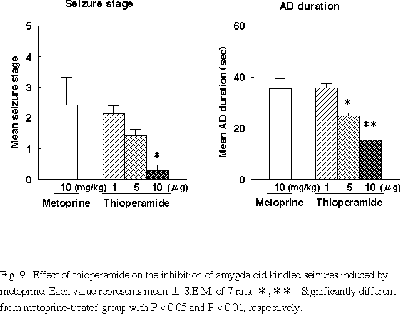Invited Symposium: Neuronal Histamine Systems and Behavior
| INABIS '98 Home Page | Your Session | Symposia & Poster Sessions | Plenary Sessions | Exhibitors' Foyer | Personal Itinerary | New Search |
Results
1. Effect of amygdaloid kindling on brain histamine contents
Rats were stimulated to the amygdala once a day. After the animals developed the final stage seizures (stage 5), the stimulation was repeated for 5 more days. Thereafter, rats were killed and brain histamine content was measured. As shown in Table 1, histamine content in the hypothalamus was slightly decreased compared with that of sham rats, but no significant difference was observed. However, a significant decrease in histamine content was observed in the amygdala, especially decrease in the histamine contents of the stimulation side of amygdala (right amygdala) was remarkable.
Table 1. Effect of amygdaloid kindling on brain histamine content (ng/g tissue) in rats------------------------------------------------------ Regions Sham rat Kindled rat ------------------------------------------------------ Cerebral cortex 31.7± 2.1 30.3± 1.8 Hippocampus 28.9± 1.7 27.5± 1.0 Thalamus 127.3± 9.7 118.4± 6.8 Hypothalamus 275.3± 21.4 238.2±11.9 Amygdala 38.5± 1.3 33.8± 1.3* Right-Amygdala 39.0± 1.8 32.5± 1.3** Left-Amygdala 38.0± 2.0 35.4± 2.3 ------------------------------------------------------ Right-amygdala was stimulated for causing kindled seizures. Each value represents mean ± S.E.M. of 8-10 rats (10 rats for sham group and 8 rats for kindled group). *, **: Significantly different from sham rat group with p < .05 and p < .01, respectively.
2. Effects of histidine and metoprine on amygdaloid kindled seizures
Effect of histidine on amygdaloid kindled seizures was shown in Fig. 1. Histidine caused a dose-dependent inhibition of amygdaloid kindled seizures both in seizure stage and AD duration. At a dose of 500 mg/kg, i.p. it elicited no significant inhibition, but at a dose of 1,000 mg/kg, i.p. histidine caused a significant inhibition both in seizure stage and AD duration at 5 hr after administration. At a dose of 1,500 mg/kg, a significant inhibition was noted from 3 to 9 hr after administration both in seizure stage and AD duration. Metoprine also inhibited significantly seizure stage at doses of 10 mg/kg, i.p. (4 hr after administration) and 20 mg/kg, i.p. (2, 4 and 6 hr). AD duration was also shortened by 10 mg/kg, i.p. (4 hr) and 20 mg/kg, i.p. (2, 4, 6 and 8 hr) of metoprine (Fig. 2).
 Fig.1: Effect of histidine on amygdaloid kindled seizures in rats.
Fig.1: Effect of histidine on amygdaloid kindled seizures in rats.
 Fig.2: Effect of metoprine on amygaloid kindled seizures in rats.
Fig.2: Effect of metoprine on amygaloid kindled seizures in rats.
3. Changes in brain histamine contents after histidine and metoprine
Histamine content of the brain was significantly increased after histidine administration (1,500 mg/kg) in the cerebral cortex, hippocampus, thalamus, hypothalamus and amygdala. An increase in histamine contents of the amygdala and hypothalamus was particularly marked. Metoprine at a dose of 20 mg/kg, i.p. also caused a significant increase in histamine content in the cerebral cortex, hippocampus, thalamus, hypothalamus and amygdala (Table 2).
Table 2 Changes in brain histamine content (ng/g tissue) after intraperitoneal injection of histidine and metoprine -------------------------------------------------------------- Region Control Histidine Metoprine -------------------------------------------------------------- Cerebral cortex 31.3± 3.7 81.9± 6.8** 69.8± 3.5** Hippocampus 23.7± 2.0 49.2± 5.6** 69.2± 3.0** Thalamus 109.6±18.5 284.3±30.1** 63.1± 5.1** Hypothalamus 270.9±22.6 840.2±65.9** 573.9±20.8** Amygdala 36.3± 3.2 118.7± 9.6** 127.1± 5.5** -------------------------------------------------------------- Brain histamine contents were measured at 5 hr and 4 hr after injection of histidine (1,500 mg/kg, i.p.) and metoprine (20 mg/kg, i.p.), respectively. Each value represents mean ± S.E.M. of 8-10 rats (10 rats for control group, 8 rats for histidine treated group and 8 rats for metoprine treated group). **: Significantly different from control group with p < .01
4. Correlation between an inhibition of kindled seizures and an increase in histamine contents in the amygdala
To investigate the relationship between an inhibition of kindled seizure and an increase in histamine content of the amygdala, effects of histidine and metoprine on kindled seizures and histamine contents were studied. Thereafter, the regression line of Y (an inhibition of kindled seizures) on X (an increase in histamine contents of the amygdala) and the correlation coefficient (r) was calculated. As shown in Fig. 3 the regression line of the inhibition of seizure discharge and an increase in brain histamine content of the amygdala is Y=0.043X - 0.226, and r=0.9739 suggesting there is a high correlation between an inhibition of kindled seizures and an increase in histamine content of the amygdala.
 Fig.3: Correlation between an inhibition of kindled seizures and an increase in histamine contents of the amygdala.
Fig.3: Correlation between an inhibition of kindled seizures and an increase in histamine contents of the amygdala.
5. Effects of H1-antagonists and H2-antagonists on the inhibition induced by histidine
Pretreatment with an H1-antagonist, diphenhydramine resulted in a significant antagonizing effect on histidine-induced inhibition. At doses of 5 and 10 mg/kg, i.p. a significant effect was noted both in seizure stage and AD duration. Almost the same findings were observed with chlorpheniramine; at doses of 5 and 10 mg/kg, i.p. of the drug caused a significant antagonistic effect on an inhibition induced by histidine (1,500 mg/kg, i.p.) (Fig. 4).
 Fig.4: Effects of H1-antagonists on the inhibition of amygdaloid kindled seizures induced by histidine.
Fig.4: Effects of H1-antagonists on the inhibition of amygdaloid kindled seizures induced by histidine.
On the other hand, an H2-antagonist, zolantidine did not antagonize on an inhibition of kindled seizures induced by histidine even at a dose of 50 mg/kg, i.p. Same results were obtained with ranitidine (Fig. 5).
 Fig.5: Effects of H2-antagonists on the inhibition of amygdaloid kindled seizures induced by histidine.
Fig.5: Effects of H2-antagonists on the inhibition of amygdaloid kindled seizures induced by histidine.
6. Effect of histidine on the development of amygdaloid kindling
Histidine was administered once a day and thereafter the amygdala was stimulated electrically. As shown in Fig. 6 the development of amygdaloid kindling was retarded by histidine treatment. No significant effect was observed in 1,000 mg/kg histidine-treated group. However, a significant difference was obtained in 1,500 mg/kg histidine-treated group.
 Fig. 6: Effect of histidine on the development of amygdaloid kindling.
Fig. 6: Effect of histidine on the development of amygdaloid kindling.
7. Effects of H3-antagonists on kindled seizures
Stimulation of the amygdala was done before and 5, 15, 30, 60 and 120 min after i.c.v. injection and before and 30, 60, 90, 120, 150 and 180 min after i.p. injection.
Fig. 7 and 8 show the time course and dose-response of thioperamide and clobenpropit on amygdaloid kindled seizures in rats, respectively. I.c.v. injection of thioperamide at doses of 10-50 µg caused a dose-dependent inhibition on the amygdaloid kindled seizures. For both seizure stage and AD duration, a significant inhibition was observed at doses of 20 µg (60 min after administration) and 50 µg (30 and 60 min). Almost the same findings were obtained with clobenpropit (Fig. 7). Following i.p. injection, thioperamide was also effective in depressing amygdaloid kindled seizures both in seizure stage and AD duration at 5 and 10 mg/kg. The same results were observed with clobenpropit (Fig. 8).
 Fig. 7: Effects of i.c.v. injection of thioperamide and clobenpropit on amygdaloid kindled seizures.
Fig. 7: Effects of i.c.v. injection of thioperamide and clobenpropit on amygdaloid kindled seizures.
 Fig.8: Effects of i.p.injection of thioperamide and clobenpropit on amygdaloid kindled seizures.
Fig.8: Effects of i.p.injection of thioperamide and clobenpropit on amygdaloid kindled seizures.
8. Effect of H3-agonist on the inhibition induced by thioperamide
I.c.v. injection of (R)-alpha-methylhistamine resulted in a dose-related antagonism of the inhibition induced by thioperamide. Pretreatment with (R)-alpha-methylhistamine at doses of 10 and 20 µg caused a significant antagonism of the thioperamide-induced inhibition of kindled seizures in both seizure stage and AD duration induced by thioperamide (50 µg, i.c.v., 10 mg/kg, i.p., Table 3). (R)-alpha-methylhistamine alone did not affect amygdaloid kindled seizures.
Table 3 Effect of (R)-alpha-methylhistamine on the inhibition of
amygdaloid kindled seizures induced by thioperamide in rats
-------------------------------------------------------------
Drugs Dose Seizure stage AD duration
(µg) (sec)
-------------------------------------------------------------
Thioperamide (50 µg, i.c.v.) 1.0±0.4 12.2±4.1+
(R)-alpha-methylhistamine 5 2.6±0.6 15.3±1.3
10 3.9±0.5* 29.4±3.0*
20 4.6±0.2** 39.4±5.0**
Thioperamide (10 mg/kg, i.p.) 1.1±0.3 17.9±3.7+
(R)-alpha-methylhistamine 5 2.4±0.4 20.1±1.1
10 3.3±0.3* 30.7±2.8*
20 4.1±0.3** 35.2±1.3**
--------------------------------------------------------------
Each value represents mean ± S.E.M. (n=7).
*, **: Significantly different from thioperamide treated group,
p < .05 and p < .01, respectively.
9. Effects of H1- and H2-antagonists on the inhibition induced by thioperamide
I.p. injection of diphenhydramine and chlorpheniramine caused a significant antagonistic effect on the inhibition of amygdaloid kindled seizures induced by thioperamide. A significant effect was observed at 5 and 10 mg/kg of both drugs. On the other hand, cimetidine and ranitidine showed no antagonistic effects even at a dose of 50 mg/kg (Table 4).
Table 4 Effects of H1- and H2-antagonists
on the inhibition of amygdaloid kindled seizures induced by thioperamide
------------------------------------------------------------------
Drugs Dose Seizure stage AD duration
(mg/kg) (sec)
------------------------------------------------------------------
Thioperamide 10 mg/kg, i.p. 1.1±0.3 17.9±3.7
Diphenhydramine 1 3.0±0.3 27.9±0.8
5 3.6±0.4* 35.9±1.2*
10 4.6±0.2** 44.9±1.3**
Chlorpheniramine 1 2.3±0.3 23.9±5.3
5 3.0±0.3* 32.6±0.9*
10 4.3±0.2** 42.5±4.1**
Cimetidine 10 1.4±0.4 20.0±1.1
20 1.9±0.3 20.7±1.0
50 2.3±0.5 21.5±1.0
Ranitidine 10 1.4±0.2 16.6±2.4
20 1.7±0.2 20.0±0.8
50 1.9±0.3 21.2±1.2
-----------------------------------------------------------------
Each value represents mean ± S.E.M. (n=7).
*, **: Significantly different from thioperamide treated group;
p < .05 and p < .01, respectively.
10. Effect of thioperamide on the inhibition of amygdaloid kindled seizures induced by metoprine
The inhibitory effect of metoprine (10 mg/kg, i.p.) on amygdaloid kindled seizures was augmented by thioperamide treatment. With seizure stage, a significant effect was observed with 10 µg of thioperamide, and with AD duration, a significant effect was observed with 5 and 10 µg of thioperamide (Fig. 9).
 Fig. 9: Effect of thioperamide on the inhibition of amaygdaloid kindled seizures induced by metoprine.
Fig. 9: Effect of thioperamide on the inhibition of amaygdaloid kindled seizures induced by metoprine.
| <= Materials & Methods | RESULTS | Discussion & Conclussions => |
| Discussion Board | Next Page | Your Symposium |